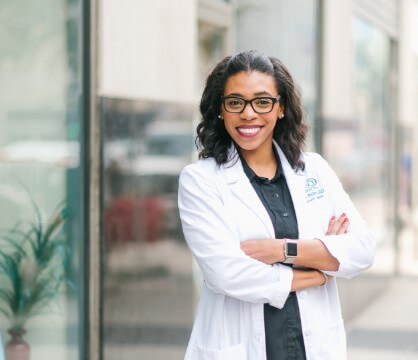- Category
- Eye Health
- Richard Lee, 17 Feb 2020

More so than any other community, African Americans are at risk for certain types of eye diseases. Even when prevention is encouraged, it’s not always a surefire way to stop their onset. One thing is for sure, though: The difference between having an eye disease and experiencing its harmful effects lies entirely in catching it early.
Did You Know? African Americans are at a higher risk for certain eye diseases.
According to the National Institute of Health’s National Eye Institute, African Americans are more likely to have cataracts, glaucoma and diabetic retinopathy than any other ethnic group. Furthermore, they are much more likely to develop these eye diseases at younger ages than their Caucasian, Latino and Asian counterparts, making early awareness and prevention even more important to maintaining good eye health.
This is important to recognize, not only because each one of these diseases has the potential to lead to severe vision loss if left undiagnosed or untreated, but also because these eye problems are very likely to be overlooked, given that they progress slowly and have few symptoms in their early stages.
Some additional risk factors for developing cataracts, glaucoma and diabetic retinopathy include:
What is diabetic retinopathy and how does it occur?
From 2010 to 2050, the number of Americans with diabetic retinopathy is expected to nearly double, from 7.7 million to 14.6 million.
“Diabetic retinopathy is a complication of diabetes that affects the eye.” says Dr. Danielle Richardson, “Elevated blood sugar levels over time can cause the blood vessels in the eye to hemorrhage which can potentially lead to vision loss.”
Here’s how diabetes can cause eye problems. When somebody has been diagnosed with diabetes, the insulin that would normally tell the body to absorb higher levels of sugar in the bloodstream, following a meal for example, stops working as effectively. Without proper treatment and management of the disease, that person’s blood sugar then remains, on average, higher than a person without diabetes. Over time this has a negative effect on the body’s delicate systems, and that includes impacting one’s vision.
When blood with abnormally high sugar levels reaches the retina—the part of the eye responsible for vision—it blocks and damages the tiny blood vessels that would otherwise serve to nourish the eye and keep it healthy. In the early stages of the disease, there are typically no symptoms, making it difficult to detect without an eye doctor’s consultation.
“Since there are no pain receptors in the back of the eye, most patients with diabetic retinopathy are unaware they have this disease,” says Dr. Danielle Richardson. Annual dilated eye examinations are recommended for all patients with diabetes because it remains the only way for us to both diagnose and treat diabetic retinopathy while preserving the patients’ vision.
What are cataracts and glaucoma?
Like diabetic retinopathy, African Americans are at a higher risk for developing both glaucoma and cataracts. Cataracts cause gradual vision loss as the lenses in your eyes become milky or cloudy. This disease, while still not to be taken lightly, is easily monitored and treated by an eye doctor. Lenses may even be surgically replaced with artificial ones should the vision loss be bad enough.
Glaucoma, on the other hand, is more serious than cataracts reputation as the “silent thief of sight.” This is due to its all but asymptomatic nature, until permanent damage has already begun to occur. Glaucoma occurs when pressure continues to build inside your eyes, usually without pain or any other sign that there is an eye problem, until the force from the pressure begins to cause damage to the optic nerve aka the cable the sends info from our eye to our brain.
With regular checkups, your eye doctor will be able to check for eye problems like cataracts and glaucoma and make precise decisions about treatments to halt their progress and avoid future eye problems, should they be necessary.
Raising awareness and preventing vision loss
First, if you have been diagnosed with diabetes at any age (Type 1 or 2), then it is extremely important to manage your blood sugar carefully and to schedule a comprehensive dilated eye exam with your eye doctor at least once per year. By managing and maintaining healthy blood sugar levels, then you’ll be much less likely to experience the damage of diabetic retinopathy.
Secondly, get regular eye exams. “A lot of people think eye exams are just for people who need glasses,” says Dr. Richardson, “but regular eye exams can also help ensure you’ll catch any first signs of eye problems like cataracts, glaucoma, or diabetic retinopathy, well before they begin to cause vision loss.”
Beyond your annual eye examination, there are things you can do to decrease your risk of diabetic retinopathy including:
Finally, although patients can’t feel diabetic retinopathy or glaucoma, sometimes they are able to perceive changes in vision. If you experience any of these symptoms, especially if suddenly, call your eye doctor immediately to circumvent any avoidable permanent vision loss:
If you are ever worried about potential symptoms or eye problems you might be having, no matter how mild or severe, simply schedule an appointment with your eye doctor for a consultation and a comprehensive dilated eye exam. He or she will be able to answer all your vision-related questions.

This blog was reviewed by Dr. Danielle Richardson. Dr. Richardson is glaucoma certified therapeutic optometrist from Indianapolis, Indiana. She is a graduate of Indiana University and holds the degrees of Bachelor of Science in Biology and Doctor of Optometry. Dr. Richardson is licensed in New York, Texas, and California and has a wealth of experience in several optometric settings. She is certified by the National Board of Examiners in Optometry to treat and manage ocular disease and currently practices in Los Angeles, CA.
Information received through VSP Vision Care's social media channels is for informational purposes only and does not constitute medical advice, medical recommendations, diagnosis or treatment. Always seek the advice of your physician or other qualified health provider with any questions you may have regarding a medical condition.
Continue Reading
If you're considering purchasing vision insurance for you or your family, here are 8 important things you’ll want to know to make the best choice poss...
Show your eyes some love this Valentine’s Day by making sure they are healthy and looking great with VSP Vision Care!
Looking for the best individual vision insurance plan? Read the top 3 questions you should ask when shopping for an eye insurance plan.
Your vision.
Your way.
Not covered for vision?
Get an individual plan, customized for you – including where you want to use it: at the doctor, in a retail location, or even online.
Healthy vision association discounts
Some plans can only be accessed through membership in the Healthy Vision Association (HVA), which helps its members see well and stay healthy.
For $1.50/mo, your membership will give you access to exclusive discount programs* on everyday goods and services including:
Plus, your membership supports vision-related charities too.
Click to download full details
*All rebates and special offers are subject to change